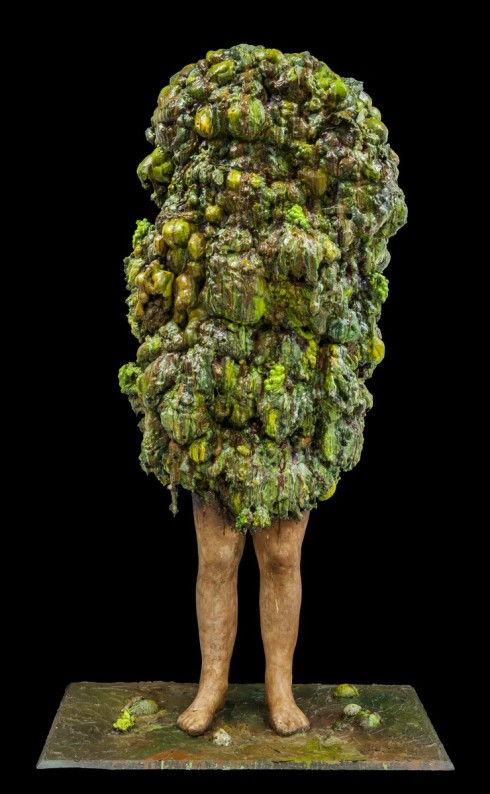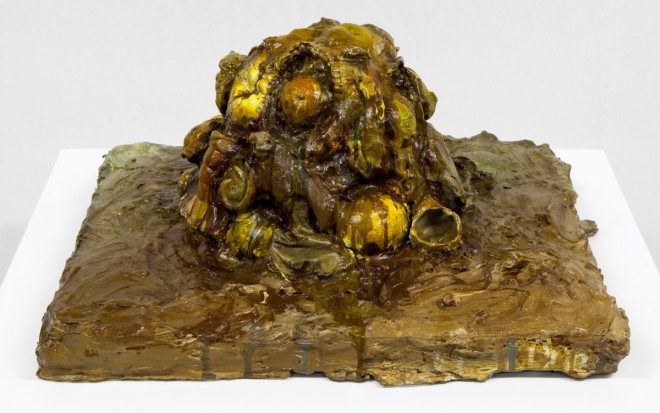Having first encountered the deliciously complex surfaces of Leonor Ruiz Dubrovin‘s ruptured images back in 2011, news of recent work being shown at Helsinki’s Galleria Kateriina (1.6.-19.6.2016) became a must-see kind of priority. And what a surprise it was! Dubrovin’s previous focus on painting has expanded considerably. In addition to her energetic mode of painting she has dived into the production of sculptures.

These works, like much of her previous output, explore the subject of death in a way that links the processes of creation and elimination, with rebirth. In her past paintings the results have sometimes reminded me of Robert Rauschenberg’s seminal Erased de Kooning, but Rauschenberg’s reasons for executing this work were entirely different. He really tried to make the image disappear. Moreover, Rauschenberg’s project was a one-off. Dubrovin, in comparison, has devoted years to this project and her modes of honing it – the fact that she has now bestowed her subject with a new physicality – suggest that there is still much that can be done.
Death, for Dubrovin, isn’t a final act. It functions as an agent of change. Her work brings viewers face-to-face with the phenomenon and, by doing so, urges people to reconsider how it may be comprehended. Among the selection of art works included here is a monochrome painting invariably altered by the extensive network of cracks, which have destroyed the uniformity of the work’s surface as well as the type of visual impact it should have or would have made. The original painted image has, for all intents and purposes, been nullified. The painting continues to exist, but it is no longer the same work.

The bust of an altar boy, who has been robbed of his identity, forms a parallel example. It is a faceless figure positioned so that his back faces the gallery’s point of entry. Only when viewers move round the work do they become aware of his literal defacement. His head is also cocked to one side, a gesture that complicates matters. It could be interpreted as a sign of embarrassment, helplessness or regret – it is difficult to say. You could say the boy is a kind of non-being. The nature of his presence surprises and engenders dismay. Both this bust and the yellow painting noted earlier are of interest because of the way they don’t attempt to meet viewers’ expectations. The key features that typically enable one to connect with the works are lacking.
Death, of course, has throughout history been depicted in many ways. The horrors of war have been captured by Goya and the photographers and painters who documented the conditions of life on the battlefield as well as the aftermath of military conflicts. Memento mori, art that depicts skulls – the most recognised image symbolising death, has been produced by the likes of Rogier van der Weyden and Cezanne as a means of reminding us of our ultimate fate. Vanitas paintings form another course of dealing with the topic. These works speak of life’s brevity through the representation of skulls, butterflies, soap bubbles and lavish displays of flowers or food.

Ars Moriendi – The Art of Dying, the title of Dubrovin’s exhibition, takes its cues from yet another aspect of this stream. Making reference to the titles of 15th century texts written to comfort people’s fears and temper the experience on one’s demise. Death back then was bound up with the church and its teachings on how to get to heaven. Those who qualified would not only be resurrected, but would also rejoin their family and friends.

In the works Growth and Paradise, the body – Dubrovin’s body? – carries a personal garden that has somehow sprouted and grown to encrusted nearly the entire form. Only the lower portion of the legs and the feet remain visible. The rest of the body is burdened by a dense and heavy mantle of vegetables and fruit so bountiful and ripe that it verges on being repulsive. Some of them have also dropped off to accumulate around the feet.

This invasive cover – call it a tree-like shroud – speaks of the body’s earthly character. It may decay, but the byproduct of that process leads to other forms of life. In Debris, another 3-D work, the body is totally absent or, perhaps, invisible. Facing us is a seemingly impenetrable cascading harvest that prevents from knowing whether a body or bodies, for that matter, are lodged.
The much smaller Untitled (Pájaros) appears to immerse a host of birds in a lavishly hued, but unidentifiable putrifactive accumulation. The bird’s power of flight normally enables it stave off dangerous situations, but here the disordered array of wings frankly illustrates that escape is impossible.

Finally, though Dubrovin now produces sculptures, it cannot be said that her ties to painting have been severed. She doesn’t just produces polychromes, but some of the forms in the works Debris and Untitled (Pájaros), in fact, resemble massively enlarged buildups of paint. Moreover, the standing figure in Growth and mound of rotting matter in Still Life (which forms the introductory image to this text) are both situated in undulating puddles of paint. If anything, these pieces reside happily between the two spheres.
Ars Moriendi – The Art of Dying possesses a dream-like aura that encompasses the positive and negative aspects of death so that it may be contemplated from many angles. And, despite Dubrovin’s extended preoccupation with the topic, the work doesn’t seem laboured or bereft of inspiration. It is simultaneously imaginative and visceral, uncomfortably awkward, morbid, intriguing. Humour is also built into the artist’s perspective. The texts that are referenced by the title intimate early self-help manuals. In this regard these old books on death management align themselves with modern volumes on etiquette, how to succeed in business and other ways of changing one’s life. Hopefully, many left the gallery like I did – looking forward to seeing future work.
Featured image: Still Life 2016, acrylic on plaster, 24 x 44 x 23 cm. ©Leonor Ruiz Dubrovin. Image courtesy the artist and Galleria Kateriina.

Someone I know? Also – it made me think of Dance of death… (Bernt Notke and Hans Holbein)
Thanks very much for your comment. The email I received notifying me of it also included the opening sentence of my post. It caused my jaw to drop slightly as I saw that the year noted there was a full century off. It has now been updated. Cheers!